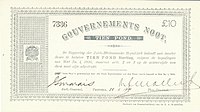South African pound
| Suid-Afrikaanse pond ( | |
|---|---|
| Issuance | |
| Central bank | South African Reserve Bank |
| Website | www |
| This infobox shows the latest status before this currency was rendered obsolete. | |
The pound (
In 1825, an imperial order-in-council made sterling coinage legal tender in all the British colonies. At that time, the only British colony in Southern Africa was the Cape Colony. As time went on, sterling and its associated coinage became the currency of every British territory in Southern Africa. At that time sterling followed the Carolingian monetary system of a pound divided into 20 shillings, each of 12 pence.
History
The pound sterling became the standard currency of the Cape of Good Hope colony in 1825 following an imperial order-in-council that was issued for the purpose of introducing sterling coinage into all British colonies. British coins then replaced the Dutch currency. Before a unified South Africa, many authorities issued coins and banknotes in values equivalent to sterling.
The
In 1920, the Treasury issued gold certificate notes. The following year, the
The South African pound was replaced during decimalisation by the rand on 14 February 1961 at a rate of R 2 = £SA 1.[2] The rand retained a 2:1 parity with sterling until sterling's devaluation in 1967 when South Africa did not follow suit.
Coins
State-issued coinage
Transvaal Republic
In 1892, the
Union of South Africa

The Union of South Africa issued coins from 1923, in denominations of 1⁄4d, 1⁄2d, 1d, 3d and 6d, 1/–, 2/– (initially denominated as a florin), 2/6, £1⁄2 and £1. (The £1⁄2 and £1 were gold coins known as the half sovereign and sovereign respectively.) The coins were the same weights as the corresponding sterling coins but the silver coins (3d up to 2/6) were struck in .800 fineness silver. Gold coins were struck until 1932.
In 1947, 5/– coins were introduced, with occasional commemorative variants. In 1951, the silver coinage switched to .500 fineness. Gold bullion £1⁄2 and £1 coins were issued from 1952 in the same specifications as the 1⁄2 and 1 sovereign.
All the coins had the monarch on the obverse, with the titles in Latin, while the reverse had the denomination and "South Africa" written in English and Afrikaans.
Banknotes
The government of the Cape Colony issued a £1 note in 1835 and a £20 note in 1834. Between 1869 and 1872, the ZAR in Transvaal issued notes for 6d, 1/–, 2/6, 5/–, 10/–, £1, £5 and £10. The National Bank of the ZAR issued £1 notes between 1892 and 1893. During the Second Boer War, government notes were issued in denominations of £1, £5, £10, £20, £50 and £100.
In 1920, Treasury gold certificate notes were issued in denominations of £1, £5, £100, £1,000 and £10,000, in Afrikaans and English script. From 1921, the South African Reserve Bank took over the issuance of paper money, introducing notes for 10/–, £1, £5, £20 and £100. £20 notes were last issued in 1933, with £10 notes added in 1943.
All banknotes were bilingual in English and Afrikaans. From 1948, two variants of each note were issued, one with English written first and the other with Afrikaans written first.
See also
- Coins of the South African pound
- South African rand
- Coins of the South African rand
- Economy of South Africa
External links
- Decimal Coinage (1962): Newsreel of South Africa's conversion to the Rand, British Pathé via YouTube
References
- ^ "Chapter 4: German-South African Experiencer under Special Exchange Agreements". Foreign-Trade and Exchange Controls in Germany. Washington D.C.: U.S. Government Printing Office. 1942. p. 242.
- ^ British Pathé (1962). Decimal Coinage (1962) (Newsreel). London. Retrieved 2022-04-21.
- Pick, Albert (1996). ISBN 0-87341-469-1.
- Krause, Chester L.; Clifford Mishler (2004). ISBN 0873497988.
- Krause, Chester L.; Clifford Mishler (1991). ISBN 0873411501.
- Pick, Albert (1994). ISBN 0-87341-207-9.

